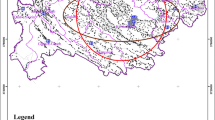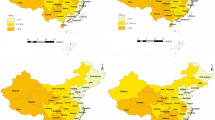Abstract
Spatial health disparity is one of the least investigated public health issues in India. Quantifying disparity and balance between health risks and health-care access are the keys for identifying the areas under stress. This study is trying to assess the regional (urban, semi-urban, and rural) disparities in health-care access and health risk exposure around Durgapur industrial region to identify areas having higher risk factors and lesser health-care access. The study explores (1) rural–urban disparity of health-care accessibility (AHCF), (2) rural–urban disparity of health-risk exposures (HRE) and social status, and (3) identifying areas under stress by comparing AHCF and HRE. The study uses multidisciplinary techniques e.g. composite index, GIS and geostatistics interpreting numerous dimensions i.e. spatial coverage and adequacy of health care facilities (HCF), people’s living standards, medical expenses, and exposure to health risk factors. We measured disparities with Quintile ratio, Sopher’s Index, test of significance correlation coefficient and independent sample t-test. The study revealed significant correlations between AHCFs and urban population percentages, indicating that urban populations enjoy better AHCFs with dense HCFs distribution over space. As the proportion of urban population decreases, so does the density and serviceability of HCFs. Despite the proximity of urban areas to pollution sources, some of the rural areas are under more stress due to local geographical factors and possessing lower AHCF, social status and higher exposure to health risk factors. Environmental restoration and ceasing further economic development in Ranigunj, Jamuria, Mejhia blocks, and decentralisation of infrastructure towards north-eastern part (North Kanksa) are recommended.

Source Reproduced from general administrative maps

Source Determined by the Author

Source: Refer to Table 2

Source: Refer to Table 2
Similar content being viewed by others
Data availability
The datasets generated during and/or analysed during the current study are available from the corresponding author on reasonable request.
References
Banerjee, U. S., & Gupta, S. (2011). Statistical evaluation of hydrochemical parameters of the Damodar river water near Durgapur industrial complex, West Bengal, India. Journal of Industrial Pollution Control.
Basu, P., & Chakraborty, J. (2016). Environmental justice implications of industrial hazardous waste generation in India: A national scale analysis. Environmental Research Letters. https://doi.org/10.1088/1748-9326/11/12/125001
Beig, G., Ghude, S. D., & Deshpande, A. (2010). Scientific evaluation of air quality standards and defining air quality index for India. Pune.
Berendes, S., Heywood, P., Oliver, S., & Garner, P. (2011). Quality of private and public ambulatory health care in low and middle income countries: Systematic review of comparative studies. PLoS Medicine. https://doi.org/10.1371/journal.pmed.1000433
Bhalla, A. S. (1990). Rural-urban disparities in India and China. World Development, 18(8), 1097–1110. https://doi.org/10.1016/0305-750X(90)90090-K
Bhan, N., Rao, K. D., & Kachwaha, S. (2016). Health inequalities research in India: A review of trends and themes in the literature since the 1990s. International Journal for Equity in Health. https://doi.org/10.1186/s12939-016-0457-y
Biswas, J. (2008). Impact of industrialization and urbanisation of durgapur (barddhaman district west bengal) on its rural movement. UNIVERSITY OF CALCUTTA. Retrieved from https://shodhganga.inflibnet.ac.in/handle/10603/154592
Bureau of Applied Economics & Statistics. (2011a). District Statistical Handbook Bankura. Kolkata: Department of Statistics & Programme Implementation, Government of West Bengal. http://wbpspm.gov.in/publications/District Statistical Handbook.
Bureau of Applied Economics & Statistics. (2011b). District Statistical Handbook Birbhum. Kolkata: Department of Statistics & Programme Implementation, Government of West Bengal. http://wbpspm.gov.in/publications/District Statistical Handbook.
Bureau of Applied Economics & Statistics Burdwan. (2011). District statistical handbook Burdwan. Department of Statistics & Programme Implementation, Government of West Bengal. http://wbpspm.gov.in/publications/District Statistical Handbook.
Chatterjee, S., & Sarkar, K. (2018). Assessment of environmental degradation through land use land cover change detection using remote sensing and gis in Durgapur city and its surroundings. Geographical Review of India, 80(2), 152–169.
Corburn, J. (2002). Environmental justice, local knowledge, and risk: The discourse of a community-based cumulative exposure assessment. Environmental Management. https://doi.org/10.1007/s00267-001-0013-3
Cowell, F. A. (2015). Inequality measurement. International Encyclopedia of the Social & Behavioral Sciences: Second Edition. https://doi.org/10.1016/B978-0-08-097086-8.44078-X
Das, D., & Pathak, M. (2012). The Growing Rural-Urban Disparity in India: Some Issues. International Journalof Advancements in Research and Technology.
Das, J., Holla, A., Das, V., Mohanan, M., Tabak, D., & Chan, B. (2012). In Urban and rural India, A standardized patient study showed low levels of provider training and huge quality gaps. Health Affairs, 31(12), 2774–2784. https://doi.org/10.1377/hlthaff.2011.1356
Drezner, T., Drezner, Z., & Hulliger, B. (2014). The Quintile share ratio in location analysis. European Journal of Operational Research, 238(1), 166–174. https://doi.org/10.1016/j.ejor.2014.03.001
Elliott, P., & Wartenberg, D. (2004). Spatial epidemiology: Current approaches and future challenges. Environmental Health Perspectives, 112(9), 998–1006. https://doi.org/10.1289/ehp.6735
Firebaugh, G. (2003). The New Geography of Global Income Inequality. Cambridge, MA: Harvard University Press. https://www.hup.harvard.edu/catalog.php?isbn=9780674019874
Ghosh, B., & Tah, S. (2015). The Impact of Urbanization on Environment: A Study in Durgapur City. Research Process, 3(2). http://srfaurangabad.org/journals/6thissue/11.pdf
Ghosh, M. (2011). Regional Disparities in Education, Health and Human Development in India. Indian Journal of Human Development. https://doi.org/10.1177/0973703020110101
Gliem, J., & a, & Gliem, R. R. . (2003). Calculating, interpreting, and reporting cronbach’s alpha reliability coefficient for likert-type scales, 2003 midwest research to practice conference in adult. Continuing, and Community Education. https://doi.org/10.1109/PROC.1975.9792
Graham, H. (2009). Introduction: The challenge of health inequalities. In H. Graham (Ed.), Understanding Health Inequalities (2nd ed., pp. 1–21). Open University Press.
Guha, D. (1996). SPATIO-TEMPORAL GROWTH OF INDUSTRIAL CENTRES AND ITS IMPACT ON URBANISATION IN ASANSOL-DURGAPUR AREA. University of Calcutta. Retrieved from https://shodhganga.inflibnet.ac.in/handle/10603/156290
Gupta, S., Satpati, S., Saha, R. N., & Nayek, S. (2013) Assessment of spatial and temporal variation of pollutants along a natural channel receiving industrial wastewater. International Journal of Environmental Engineering 5(1), 52. https://doi.org/10.1504/IJEE.2013.050893
Hajat, A., Hsia, C., & O’Neill, M. S. (2015). Socioeconomic disparities and air pollution exposure: A global review. Current Environmental Health Reports. https://doi.org/10.1007/s40572-015-0069-5
Harper, S., & Lynch, J. (2005). Methods for measuring cancer disparities: using data relevant to Healthy People 2010 cancer-related objectives. Colorectal Cancer.
Hosseinpoor, A. R., Bergen, N., Schlotheuber, A., & Grove, J. (2018). Measuring health inequalities in the context of sustainable development goals. Bulletin of the World Health Organization, 96(9), 654–659. https://doi.org/10.2471/BLT.18.210401
Klein, R., & Huang, D. (2010). Defining and measuring disparities, inequities, and inequalities in the Healthy People initiative. National Center for Health Statistics.
Krishan, G., & Singh, N. (2019). Researching Geography. Routledge India. https://doi.org/10.4324/9780429263569
Kumar, P. (1986). Durgapur industrial complex a study of industrial geography. The University of Burdwan. Retrieved from http://hdl.handle.net/10603/69206
Kundu, Anjana. (2016). Quality of population and resource utilization in the districts of West Bengal adjoining Chotanagpur plateau. University of Calcutta. Retrieved from http://hdl.handle.net/10603/211625
Kundu, A., & Rao, J. M. (1986). Inequity in educational development: Issues in measurement, changing structure and its socio-economic correlated with special reference to India. In M. Raza (Ed.), Educational planning: A long term perspectiv (pp. 435–466). New Delhi, India.: New Delhi: NIEPA and Concept Publishing Company.
Meghani, S. H., & Gallagher, R. M. (2008). Disparity vs inequity: Toward reconceptualization of pain treatment disparities. Pain Medicine, 9(5), 613–623. https://doi.org/10.1111/j.1526-4637.2007.00344.x
Mohan, I., Gupta, R., Misra, A., Sharma, K. K., Agrawal, A., Vikram, N. K., et al. (2016). Disparities in prevalence of cardiometablic risk factors in rural, urban-poor, and urban-middle class women in India. PLoS ONE. https://doi.org/10.1371/journal.pone.0149437
Moreno-Jiménez, A., Cañada-Torrecilla, R., Vidal-Domínguez, M. J., Palacios-García, A., & Martínez-Suárez, P. (2016). Assessing environmental justice through potential exposure to air pollution: A socio-spatial analysis in Madrid and Barcelona. Geoforum. https://doi.org/10.1016/j.geoforum.2015.12.008
Office of the Registrar General and Census Commissioner, India. (2011a). Tables on Houses, Household Amenities and Assets, Office of the Registrar General and Census Commissioner. https://censusindia.gov.in/DigitalLibrary/MFTableSeries.aspx.
Office of the Registrar General and Census Commissioner. (2011b). District census handbook barddhaman. New Delhi: Directorate of census operations west bengal. https://censusindia.gov.in/2011census/dchb/DCHB_A/19/1909_PART_A_DCHB_BARDDHAMAN.pdf.
Patil, A. V., Somasundaram, K. V., & Goyal, R. C. (2002). Current health scenario in rural India. The Australian Journal of Rural Health. https://doi.org/10.1046/j.1440-1584.2002.00458.x
Prüss-Üstün, A., & Corvalän, C. (2007). Preventing disease through healthy environments: Towards an estimate of the environmental burden of disease. Engenharia Sanitaria e Ambiental. https://doi.org/10.1590/s1413-41522007000200001
Rushton, G. (2003). Public health, GIS, and spatial analytic tools. Annual Review of Public Health, 24(1), 43–56. https://doi.org/10.1146/annurev.publhealth.24.012902.140843
Sen, S. (1981). Aspects of urbanization in Durgapur industrial complex. University of Calcutta. Retrieved from http://hdl.handle.net/10603/159459
Sopher, D. E. (1980). Sex disparity in Indian literacy. In D. Sopher (Ed.), An exploration of India: Geographical perspectives on society and culture (pp. 130–188). Cornell Press.
Tah, S. (2016). Urbanization and environmental issues a comparative study of barddhaman and durgapur municipal areas west bengal. The university of burdwan. Retrieved from http://hdl.handle.net/10603/204521
West Bengal Pollution Control Board. (2010). Bio-medical waste inverntory and status of management in west bengal. Kolkata. http://web.wbpcb.gov.in/html/downloads/report_BioMedicalWaste.pdf
World Health Organization. (2002). World Health Report 2002 - Reducing Risks , Promoting Healthy Life. World Health Report.
Yamada, I. (2016). Thiessen Polygons. In International Encyclopedia of Geography: People, the Earth, Environment and Technology. https://doi.org/10.1002/9781118786352.wbieg0157.
Yang, T.-C., Shoff, C., & Noah, A. J. (2013). Spatialising health research: What we know and where we are heading. Geospatial Health, 7(2), 161. https://doi.org/10.4081/gh.2013.77
Acknowledgements
This study is supported by UGC-NET JRF fellowships by the University Grants Commission of India and the Department of Geography at Jadavpur University. The authors would also like to thank Dr. Kaberi Samanta and of the School of oceanographic studies, Jadavpur University for her help.
Funding
This study is supported by UGC-NET JRF fellowships by the University Grants Commission of India and the Department of Geography at Jadavpur University.
Author information
Authors and Affiliations
Corresponding author
Ethics declarations
Conflict of interest
The authors declare that there is no conflict of interest, i.e. they have no known competing financial interests or personal relationships that could have appeared to influence the work reported in this paper.
Human and animals rights
This article does not contain any studies with human participants or animals performed by any of the authors.
Additional information
Publisher's Note
Springer Nature remains neutral with regard to jurisdictional claims in published maps and institutional affiliations.
Rights and permissions
About this article
Cite this article
Chatterjee, S., Sarkar, K. Appraisal of urban–rural disparities in access to health care facilities and exposure to health risk factors: A case study of Durgapur Industrial region, India. GeoJournal 87, 4007–4024 (2022). https://doi.org/10.1007/s10708-021-10480-9
Accepted:
Published:
Issue Date:
DOI: https://doi.org/10.1007/s10708-021-10480-9




